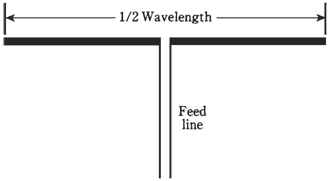Antennas:
Several types of antennas exhibit resonant properties. The simplest type of the resonant antenna, and only kind which will be mentioned here, is center fed, half wavelength dipole antenna.
The length Lft, in feet, for the half wave dipole at the frequency of fo MHz is given by the formula given below:
Lft = 468/fo
This takes into account the fact that the electromagnetic fields travel along with the wire at about 95 % of the speed of light. If Lm, can be specified in meters, then
Lm = 143/fo

Figure-- A half wave dipole antenna.
A half wave dipole contains a purely resistive impedance of around 70 Ω at resonance. This is similar to series resonant RLC circuit having R = 70 Ω.
A half-wave dipole is the resonant at all the harmonics of the fundamental frequency fo. The dipole is full wavelength at the 2fo; it is 3/2 wavelength long at the 3fo; it is 2 full wave lengths long at the 4fo and so on. At fo and odd harmonics, which means, at fo, 3fo, 5fo and so on, the antenna acts like a series resonant RLC circuit with the fairly low resistance. At the even harmonics, which means, at 2fo, 4fo, 6fo, and so on, the antenna behaves like a parallel resonant RLC circuit having a high resistance.
But, you say, there isno resistor in the diagram of figure given below. Where does the resistance come from? This is very interesting phenomenon which all antennas have. It is known as radiation resistance, and is a crucial factor in design of any antenna system. When the electromagnetic energy is fed into an antenna, power flies away into the space as radio waves. This is the form of true power. True power can be always dissipated in a resistance. Although you do not see any resistor in the figure, the radiation of radio waves is, in effect, the power dissipation in a resistance.